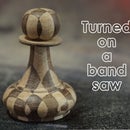Introduction: Ruler Compass
A ruler is built to draw straight lines....but what if you want to draw circles!
Every workshop needs one of these Ruler Compass's....
Step 1: Supplies + Tools
BITS
Metal ruler of choice...for info. the ruler I used was a 300mm ruler with some additional space to the end total length of 335mm and a width of 25mm
A ball race bearing, diameter small enough to fit within the width of the ruler...I used a 22mm diameter bearing for this project
TOOLS
Metal punch
Drill bit 1mm
Drill press or cordless drill
Large hole cutter to slightly less than bearing diameter...a stepped cutter works well
Metal file
Cutting fluid
Rotary tool with sanding bobbins
Propane blow torch
Adhesive backed vinyl
Spray mount glue
Spray can colour of choice
Computer + printer to print out the PDF template
Optional... Router and old woodworking router bit
Step 2: The Idea
The idea for this project is really simple...
...attach a bearing in a metal ruler that acts as the centre of a circle...
...drill hundreds of 1mm spaced holes along the ruler length...
...place a finger on the middle of the bearing...use a sharp pencil in the desired hole and spin around the bearing...
...draw circles!
The compass I made will draw circles from 15mm radius to 317mm which gives a whopping 620mm diameter circle capacity...the smaller sizes are trickier with a long ruler, though I also have made a smaller 150mm ruler compass that works well for the smaller sized circles...
...and it is still a ruler for measuring and drawing straight lines.
The idea was sparked by an advert on Instagram with a small machined metal bar and a bearing to draw circles...I felt it wasn't long enough and the increments were every 5mm...I wanted every millimetre.
Step 3: Work Out the Holes
I have made your job easy by doing this part for you!...down load the PDF to print out your own template.
The template is millimetre accurate with the centre being from the centre of the bearing hole...
...1mm concentric circles projected from this centre point and the location for the holes were set to one side of the ruler...in my case to cover the inches side which I do not use here in the UK
The positions of the holes vary as you progress along the ruler due to the proximity to the centre point and position across the ruler...just be glad that you don't have to undertake this task!
A point to note-
I made this ruler compass by hand, punching and drilling the holes with hand tools.
With as much care as can be taken it is difficult to get it pin point accurate, some of my holes are out a little, maybe a half millimetre discrepancy which I feel is acceptable for a workshop compass.
Total accuracy would be achievable if you have access to a CNC machine.
Note of PDF Template
I have re-uploaded the template PDF file with a 100mm marking on the template.
When printing make sure it is printed A4 at 100%.
When printed make sure the 100mm marking measures 100mm!
If it does not, check your printer settings, things like 'checking' borderless printing can throw out the print scale.
Attachments
Step 4: Template
Cut out the template...
...attach to the rear of the ruler with some spray glue...
...the rear of the ruler is best so that any indented measurement markings don't interfere with the punched marks.
Step 5: Punch
To enable the drill bit to locate at the correct position...
...punch each and every hole marking...
...this will take some time as there are around three hundred holes to punch...
...time and care taken here will result in accurate hole placement.
The thin metal ruler will deform a little as you punch the holes...gently bend the ruler back flat.
Step 6: Drill
I used a 1mm drill bit in a pillar drill...this gives a large enough hole for a sharp pencil and small enough to give space between the holes.
Drill 300 holes!
Remove the paper template and use a metal file to remove any metal burrs.
Step 7: Remove the Inches!
THIS STEP IS TOTALLY OPTIONAL
I wanted to have a clean area on the top of the ruler on the side of the holes...
...this would allow the holes to be more visible and to allow measurement markings to be applied...
...and to make the ruler a little thinner for the ease of using the pencil through the holes.
The compass will still work if you do not do this step.
Router out the ruler shape in a piece of wood to the depth of the ruler...
...apply double sided tape in the groove and stick the ruler in nice and secure.
Apply some cutting fluid to the top of the ruler.
I used an old wood working router bit that was being thrown out as it was no longer sharp enough for woodworking.
Set into a router and use a fence to set the cutter to cut half way across the ruler.
Set to skim off the smallest amount from the ruler, just enough to remove the indent markings.
Please WEAR PROTECTION EQUIPMENT, small shards of metal will be cut off...eye protection is a must.
Carefully router off the metal.
Step 8: Bearing
You will need to drill a hole smaller than the bearing diameter at the end of the ruler...
...I found a stepped cutter worked well for this cutting a 20mm hole...
...carefully increase the size of the hole towards the 22mm diameter of the bearing with a multi tool and a sanding bobbin...
...you want a hole that is fractionally smaller than the bearing...take your time DO NOT GO LARGER
Step 9: Expand the Metal
This is where the magic happens!
Use a blow torch to heat up the end of the ruler with the hole for the bearing...it wont take long to heat...
...the metal will expand a little...
...slot over the bearing...
...make sure a little of the bearing protrudes below the ruler...
...let it cool...
...a super clean tight fit
Step 10: Measurments
I decided to have measurement markings every 25mm up the compass holes to make finding the correct position easier...
You could easily write these on with a Sharpie...
...or if you have a steady cutting hand or a vinyl cutter...cut out some vinyl stencils...
...stick them on at the correct positions along the ruler...
...mask up the remaining spaces...
...and spray with your choice of colour...
...carefully remove the stencils and leave to dry.
Step 11: Options
Draw circles with a ruler!
I can't tell you how useful this tool is in the workshop...you are just going to have make one for yourself and find out.
If you don't fancy working with metal why not make it with a plastic ruler...
...I made my prototype with a smaller 150mm plastic ruler and hot glued in a bearing...works great for the smaller circles...
You don't even need a ruler, just use a thin strip or metal, plastic or even very thin ply.
TOP TIP- Need more accuracy for the centre point...cut out a circle of thin plastic film and draw or score cross hairs through the middle...super glue to the bottom of the bearing
Step 12: Draw a Circle With a Ruler!
So easy to use...
Place the bearing on the centre point of the circle...
...place a finger on the centre of the bearing [inner ring]...
...select the hole for the circle radius...
...use a nice sharp pencil in the hole and spin around the bearing while keeping pressure down on the bearing with your finger...
...and draw a circle!
...and oh yes it still works as a ruler and straight edge!
Thank you so much for making it to the end.
I so hope that you will make one for yourself...if you do please post a picture in the comments, I would love to see it.
If you liked this project I would be stoked if you voted for it in the Made With Math Competition...
...and remember...Rulers have never been so exciting!!

First Prize in the
Made with Math Contest














